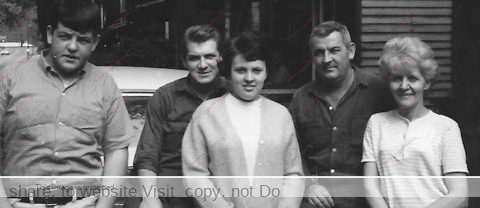
Mountain Woman: Reflections on Life in the Appalachian Coalfields
by Matt Browning at mattbrowningbooks.com
Earlier this year, I was invited by Voices of Appalachia to write a piece about Appalachian culture. I chose to interview my mother about her experiences growing up, getting married, raising a family and retiring in the coalfields of Logan County, W.Va.
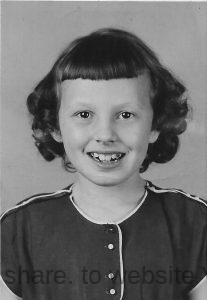 On a typical Sunday morning drive through Omar, W.Va., about 10 miles south of the Logan County seat, there’s little activity along the two-lane road that winds its way through the community. Once a bustling coal town nestled between the mountains, empty storefronts and pothole-lined streets suggest a place whose best days may be behind it. Yet children’s toys line front yards, people gather at the lone filling station to discuss the day’s news, and the parking lots of the area’s many churches spill cars into the street.
On a typical Sunday morning drive through Omar, W.Va., about 10 miles south of the Logan County seat, there’s little activity along the two-lane road that winds its way through the community. Once a bustling coal town nestled between the mountains, empty storefronts and pothole-lined streets suggest a place whose best days may be behind it. Yet children’s toys line front yards, people gather at the lone filling station to discuss the day’s news, and the parking lots of the area’s many churches spill cars into the street.
For some longtime residents, however, this version of Omar is far removed from the one of years past. And yet, it remains home.
At age 3, Kathy (Sizemore) Browning moved with her parents and younger brother from Norton, Va., to Omar. The year was 1951, and Kathy’s father, a World War II veteran, was seeking work in the coal mines. Built upon a thriving coal industry, Omar seemed as good a place as any to settle down.
“Dad and my uncle decided to move to West Virginia I guess because the coal jobs were available, and it wasn’t too far from where we were at the time,” Kathy says. “Plus, they both played baseball, and the coal companies had teams.”
Kathy’s early memories of the town differ greatly from what she sees today. “Back in those days, there were nice stucco homes, the big general store, and there was a theater near the train tracks that’s long gone.”
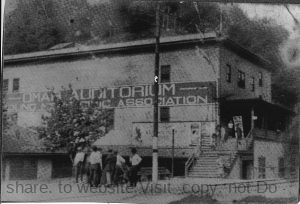 The Sizemore family moved into an apartment above the theater, where a young Kathy quickly made herself at home. “I used to go downstairs, and the women who worked at the theater would let me run up and down the aisles or play in the ticket booth. They let me have the run of the place.”
The Sizemore family moved into an apartment above the theater, where a young Kathy quickly made herself at home. “I used to go downstairs, and the women who worked at the theater would let me run up and down the aisles or play in the ticket booth. They let me have the run of the place.”
Jobs like working at the theater, though, were rare. In Omar, if you were employed, it was most likely in the mines or for the company that owned it.
“I don’t know of anybody that didn’t work for the coal company. That’s all there was as far as I know,” Kathy says. “The coal company owned everything – the store, the houses you rented. All of it.”
The miners wouldn’t get paid in money. They’d get what they called scrip that they’d use at the company store in exchange for goods. The store stocked everything a family would need, from food to furniture to clothes. People would place a call to the store, give the clerk their list, and the order was delivered to the front door, because no one had transportation unless they owned a horse. In fact, the grocer wasn’t the only one making house calls. The town doctor – also a coal company employee – would come to those in need.
“Dr. Moore was the doctor’s name, and if you got sick, he’d come to the house,” Kathy recalls. “You always got a shot of penicillin and those old gray cough tablets that were like charcoal. You knew when you’d see him coming that you were going to get a shot, so we’d start crying the minute we saw him coming up the road.”
From the basic needs of food and shelter to medical care, it was all controlled by the coal company. Kathy recalls a line from the Tennessee Ernie Ford classic “Sixteen Tons,” which, she says, rang true for the people of Omar.
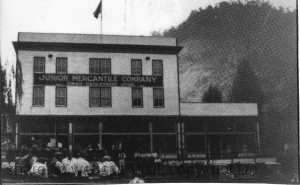 “There’s that old song lyric, ‘I owe my soul to the company store.’ It was the truth. There were many times Dad didn’t get a paycheck. He owed it all to the company store. We used to go to the soda fountain in the store and order milkshakes and candy and charge that to Dad’s account, too.”
“There’s that old song lyric, ‘I owe my soul to the company store.’ It was the truth. There were many times Dad didn’t get a paycheck. He owed it all to the company store. We used to go to the soda fountain in the store and order milkshakes and candy and charge that to Dad’s account, too.”
Having the secure income that a coal job provided didn’t mean life was easy. Many of the homes didn’t even have indoor plumbing.
“We moved from the theater to a small place in nearby Chauncey that had a gas furnace and inside bathrooms. I think we were the only house in Chauncey that had that. And all the school teachers at the four-room schoolhouse down the hill would come up to our house and smoke with Mom during recess.”
This lifestyle carried Kathy through her childhood, but in the early 1960s, she noticed things beginning to change. As automobiles became more prevalent, people were less reliant on the coal company store and were venturing elsewhere for their needs.
“We moved from Chauncey back to the main street in Omar when I was in the 10th grade, and it was around then I noticed things were getting a little bit better. More people had cars, and they’d drive to Logan to shop or go to the old drive-in theater in Monitor. They had the best hamburgers you ever had in your life at that theater.”
Slowly, the days of coal company-owned life dwindled as more and more people ventured beyond Omar’s borders to trade. Even then, the decline in the coal industry was evident as mines began to close and people moved on.
“People just got away from that,” Kathy says. “Just like now, mines would close down, people would move away, same as it is today. It seems to me that around the time I was in high school, all those things were gone – the theater, the store, they weren’t there anymore. Once people got transportation, they were going to Logan to do their shopping.”
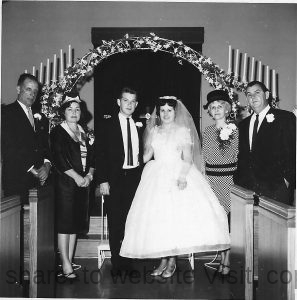 While in high school, Kathy met her future husband, Stacey Browning, the son of her first and second grade teacher, Inamae Crockett Browning, a descendent of frontiersman and politician Davy Crockett. The two dated while Kathy finished high school and married in November 1966, shortly after her graduation.
While in high school, Kathy met her future husband, Stacey Browning, the son of her first and second grade teacher, Inamae Crockett Browning, a descendent of frontiersman and politician Davy Crockett. The two dated while Kathy finished high school and married in November 1966, shortly after her graduation.
“He bought me a ring. It had a little, tiny, itty-bitty diamond that was so small you couldn’t even see it. I don’t even have it anymore. I lost it down the sink!”
The newlyweds rented a small house in the nearby hollow of Cow Creek.
“We paid $25 a month in rent,” she says. “Stacey delivered for the bakery, and I worked at Dot Discount, a drugstore, and then at Sayre Bros. department store. We didn’t have a car at first, so we got a ride to town with our neighbor, or Stacey would bring the bread truck home sometimes.”
The couple eventually moved to Delbarton, in Mingo County, and had their first child, daughter Cindy, in 1970. They then moved to a mountaintop on the West Virginia-Kentucky border.
“Stacey was a forest ranger, and I got a job as a tower observer,” she says. They lived in a small cabin at the base of the tower. “It was a nice little cabin, had a shower in the basement, and the toilet was outside, over the hill.”
Watching for fires proved to be a secure job.
“Lord have mercy, the world would burn up! There were always fires going,” she recalls. “They paid 25 cents an hour to fight fires, so people would set fires just to get the 25 cents an hour to go fight them.” The remote location of a mountaintop tower, however, didn’t necessarily provide security. “I wore a holster and a gun,” Kathy says. “People would try and break in on you up there in those towers.”
With so many hours to kill and so much to see from a mountaintop tower, it was easy to become distracted if activity did occur, whether or not it was fire-related.
“On Sundays, all the young people would come up and make out in their cars on the hill where I was. So one day, I had my binoculars out, and I was watching them. I got a call on the radio saying, ‘Mingo, I’m seeing a lot of smoke in your area. You got a fire over there?’ I turned around and the whole daggone mountainside behind me was burning up while I was watching the lovebirds!”
Eventually, Mother Nature wore out her welcome on the mountaintop. The storms were so strong that wind would jostle the tower, and lightning would often strike the cabin, burning up the telephone line and light bulbs. It became too much for the Brownings.
“It’d scare our German Shepherd to death. He’d disappear for hours at a time during a storm.”
 After coming down from the mountain, the family lived with Kathy’s parents for a time, then moved to the Mingo County town of Red Jacket before landing once again in the Omar area, first in the Barnabus community then back to Cow Creek. Stacey and Kathy welcomed two more children along the way – son John in 1976 and Matthew in 1980 – and have called Cow Creek home ever since.
After coming down from the mountain, the family lived with Kathy’s parents for a time, then moved to the Mingo County town of Red Jacket before landing once again in the Omar area, first in the Barnabus community then back to Cow Creek. Stacey and Kathy welcomed two more children along the way – son John in 1976 and Matthew in 1980 – and have called Cow Creek home ever since.
Kathy has watched the coal industry’s effect on her town from its early, successful days, to its steady decline. She recalls her life in Omar with a fondness that, while still evident, has shifted in recent years.
“I liked it better back then. Now a lot of the houses are run down. Back then, the houses were nice – the coal company houses. You had people out on their porches talking all the time. You don’t see that much anymore.”
It’s still a good place, still home, she says. But different.
“You might as well say Omar is like a ghost town compared to back in those days, because you had so much going on. Nobody had any money, but there was a lot going on. Everybody got along. Us kids would go outside and go into the mountains and play and stay all day. We didn’t have to worry about anybody kidnapping us. It was a different set of problems than what goes on today.”
With the expansion of cleaner and cheaper energy sources and stricter environmental regulations on coal mining, leading to what some in the region call a “war on coal,” many people who have long relied on coal to put food on their family’s table are left without a job – or a marketable skillset to fall back on.
“It’s bad. The coal mines keep closing down. They’re laying off so many miners,” Kathy says. “There’s hundreds and hundreds laid off every other week around here, it seems. The government has been trying to train people to do other stuff, but I don’t know how that’s going to work out. A lot of people could end up having to move away to find work.”
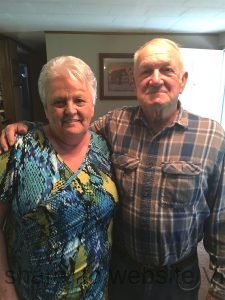 Many in the region are hoping that changes in the political landscape, including electing coal magnate Jim Justice governor of the state, could help to turn the tide. While Kathy is hopeful for a better future for her town, she’s also cautiously realistic. Now retired, and with their children long out of the house, will she and Stacey consider a move out of Omar? It isn’t likely.
Many in the region are hoping that changes in the political landscape, including electing coal magnate Jim Justice governor of the state, could help to turn the tide. While Kathy is hopeful for a better future for her town, she’s also cautiously realistic. Now retired, and with their children long out of the house, will she and Stacey consider a move out of Omar? It isn’t likely.
“Stacey wouldn’t hear of moving away,” she says of her husband, now 70, who was born in Cow Creek. “And I wouldn’t want to be too far away from the kids.”
Daughter Cindy married a coal miner and lives with her family in nearby Switzer. Older son John and his family reside in Logan, and youngest Matthew in Charleston, the state’s capital city. Kathy and Stacey welcomed their first great-grandchild in 2016.
In November 2016, Kathy and Stacey celebrated their 50th wedding anniversary. At age 67, with an extended family of children, grandchildren and great-grandchildren, packing up and leaving just doesn’t seem worth it to Kathy at this point in her life.
“Really, when you get to be our age, you’re too old to go anyway.”
Like so many of the mountain men and women in the town of Omar, for Kathy Browning, it would seem her roots are firmly planted. As the times continue to change, however, what will grow around those roots remains to be seen.
*Published here with permission and our special thanks.
My best friends, Lois Nicholls, Sandy Moore, Nan Hatfield, Carol Lindamood, Bobby and Danny Marshlander, Mildred Cook, my Aunt and Uncle Louis Hernandez, Dorothy Martin lived in Omar. My bestie, Drema Jenkins. She was one of the most perfect human being I have ever met and there is no doubt, she is with her family in heaven. Georgie, her Mom and sisters Juanita and Patti. Donna Borders in Switzer. My cousins, Margie , Bobbie in Switzer too near Jimmy’s drive in. Life was sweet and dear 40’s and 50’s. I lived in Switzer and Stirrat with two sets of railroad tracks with feet from the front of the two coal company management houses, near Hatfield bottom,
Mary Ann Pichardo Gibson, 08/24
Kathy, I lived in Cow Creek until I was ten years old, before moving to Raleigh Co. I’m trying to find a picture of Barnabus School but can’t find one anywhere. Mrs Jordan, my second grade teacher at Barnabus, told me the story of my daddy burning down two of the four rooms of the school when he was a kid, hence the concrete slabs that were in the schoolyard. Also, I think Daddy talked fondly of your husband, Stacie. His name was Buster Nelson. Our last home before moving, was at the end of the hollow called Old House Branch and Daddy built the school bus shelter at the end of the hollow. I loved reading your story; brings back so many memories!
Thank you for the very kind comment about my grandfather, Dr Moore. We all still miss him very much.
Hello, I lived in Stirrat and I remember your grandmother telling my Mom, that there was a picture in her attic that she wanted me to have because it looked just like me. I am Mexican American. Not sure if she said it was a picture of an Indian female ? I am 79 and too long algo. I loved your Grandmother. She was so caring and sweet.
Dr Moore’s wife, my grandmother, was a kind and generous woman. Thank you for your kind words.
Loved my childhood
Many fond memories
I Remember going to the company store, the teen hop
The drive in movies
I Remember Dr Moore
He even n me add a house call to see my dad
Love my childhood
Thanks for bringing up done very fond memories
I am very happy that you have fond memories of my grandfather, Dr Moore. He loved the people in the Omar area dearly. Leslie Moore Rivers
Thank you so very very much Kathy. Your story brought back so many memories of my childhood. I still have the Santa Clause cup that Dr. Moore’s wife made for us in 1st grade. I was born at Logan General Hospital in 1953. Out family moved away after my dad was hurt in a mining accident and wasn’t able to work there anymore. I live outside of Nashville Tennessee and long to see my old home although I’ve heard it’s no longer there. Maybe one day soon.
Bless you again for sharing your memories.
Roy Shelor Jr
Thank you for the kind comments about my grandparents. Although my grandfather Dr Moore has been deceased since 1971 and my grandmother since 2010, I miss both every day. Please continue to tell me stories you have about them.
If you click on his name it will take
you to his website where you can
buy his books.
Matt Browning wrote a wonderful story.
Great story I lived in Hatfield Bottom for awhile from 7&8 Holden in Logan county my home and yes we owe our soul to the company store
REGGIE CHAUNCEY NEDD
Loved reading Kathy’s story.
I grew up at Crystal Block & Sarah Ann WV. I can relate to being the daughter of a coal miner & basically owing “Your Soul to the Compant Store”. My Dad Charley Hunt worked in the mines at Crystal Block, Stirrat and Pinecreek. Worked as a miner for over 35 years. I believe my family lived in the coal camp at Crystal Block for a while; then purchased land & built their home in a holler at Sarah Ann. Mom lived there after we all moved away & after Dad passed in 1986. A coal company purchased all the homes in the holler & Mom moved to Chapmansville. All the homes in the holler were demolished. My two younger sisters and visited Logan County several years ago. We drove to Sarah Ann. There is no evidence of any homes in the holler. Mining company built the road almost to the top of the mountain. We also visited the Hatfield Cemetery. And of course went to Morrison’s in Logan. My siblings and I all settled in different states. My brother & I live in Indiana. My 3 sisters were all in KY for a while, the oldest settled in VA.
This was a most enjoyable story of times past and the folks that lived in that era. I had a great friend on Omar, Charles Carroll. and spent a few days in the community. Every person met there were just very cool and comforting. Those were the great old days and reminded me of the sories of Chapmanville and the coal mines in surrounding communities. What a great collection of folks in that area also. Thanks for the great stories and enjoyed reading this one immenslly. Thanks for your living in thqat golden area kk
Matt, I enjoyed your story and got some chuckles along the way. It cracked me up to read that the teachers went to your mom’s house to smoke during recess. Who watched the children?! When I think back to my elementary days, the teacher didn’t come out with us to watch over us the way the teachers have to do today. I went the first two years of my schooling in a one-room schoolhouse on Dempsey Branch at Mud Fork. Back then, in 1956, there was no public kindergarten. From there, I went to Mt. Gay Grade School. Logan Central on the hill was my junior high school. In ninth grade, I was given the girl’s Citizenship Award. Jack Bailey got the boy’s award. I was totally surprised and cried. I graduated from Logan High School and went on to graduate from Marshall University.
Went to school with David Sayer, the son of the owner of Sayer Bros. 50’s were great days in Logan and vicinity. Left there in ’55 for Cleveland Ohio.
Harry, did you once work for Island Creek at Mine No. 23?
Robert
All those coal camp names are still familiar even though I’ve been away from the county many years. I remember a number of Logan High School (class of 1945) classmates from the area and for several years had dates off an on with an Omar girl, Eleanor Lindamood. Other people that come to mind are Clara Disco, Dale Shaheen, the Guy twins, Homer Herman, the Winter family of Micco, Jimmy Reed, Bill Abraham — I think he ended up owning a railroad passenger car! — and Dickie Brewer Last year I cruised Main Island Creek all the way up to Horsepen Mtn. and like so many others, was sorry to see the area’s general decline..
My Mom and family born and grew up in and around Omar! Brings sweet memories of her stories!
Thank you for the nice comments about my grandfather, Dr Moore. As his granddaughter, he dispensed the same medicine to me as he did his patients. When I was in the 3rd grade, I lived with my grandparents in Omar. I was (still am) a severe asthmatic. My grandfather was able to provide the constant care that I needed in order to survive. PaPa liked history, particularly the Civil War. When I was sick, he would talk about the generals and battles in the Civil War. I really didn’t understand what he was talking about. When I got to college, I majored in US history, specifically the Civil War, because of PaPa. Today, I am retired from the NC public school system. As a retiree, I help historical societies get historical highway markers installed all over the state of NC. As a child, I rode with my grandfather when he made house calls.
I remember going to see Dr. Moore many times. His office was next to the Company Store.
Yes, Dr Moore’s office was.
Great Read,Awesome!
I don’t ever remember a time in my life that these wonderful were not a part of. To this day I consider them family. Love the article, thanks Matt.
Great story Kathy, and I have enjoyed going to school and knowing you all of these years. Things were great back when we were growing up and we didn’t have a lot but we were happy. We have all worked hard all of our lives and have made great friends here in Logan county. You just don’t find these kind of people everywhere you go!
Great story. Kathy is such a beautiful lady, inside & out. ❤️
Dear Kathy, I really enjoyed your story and as you mentioned The places and schools, the memories came flooding my mind, I attended Omar School and then Logan High. My Dad lost his coal mining job and we moved to Florida. I attended the Barnabus Church of God Sunday School and played guitar and sang. Yes the fifties were wonderful in Omar WV, ???? Gayle Musick
Wow what an incredible story!!! I lived in one of the homes on Front St. In Omar. Wonderful memories!!! Now in South Ga, but WV will always be home!!!
I remember Stacy and his brother Tracey Browning! I played little league at Omar! Nice story!
Enjoyed reading about Omar. My grandfather was Dr Moore. Loved going there for visits, We lived in NC. I was last there for Christmas in 1971, my grandfather died in October 1971.I see that my grandparents house is still there. Many fond memories as a young child and snow for Christmas.
Wonderful nostalgic story. Col. Robert Hanger, orig in Peach Creek,
now RET in San Angelo, TX.
I remember a lot of your story as I walk through my own life growing up in Chauncey of course not exactly but I loved my life in the hills
I remember Dr Moore like it was yesterday the company store and the dancing in the streets
Hilbert was my maiden name
Love